At the end of May, B2Gold (TSX: BTO; NYSE-AM: BTG) officially opened a 7-megawatt solar power plant at its Otjikoto mine in Namibia. The solar plant is one of the first fully autonomous hybrid plants in the world, and will allow B2Gold to lower greenhouse gas emissions and power generation costs from the site’s 24-megawatt, heavy fuel oil (HFO) power plant.
A feasibility study on integrating solar power with the 24-megawatt HFO plant was completed in mid-2016. The study indicated a saving of 20% per year on HFO consumption through the reduction of load to the HFO power plant. In addition to less HFO consumption, there will be lower maintenance costs on the HFO power plant’s engines by shutting down one of the HFO engines during the day. The company expects the plant will drop the mine’s overall power-generation costs by 14% a year. The payback of the plant, which cost $8.5 million, is forecast to take between four and a half to five years.
Now the company is assessing whether to move ahead with two other phases. Phase two could include building a 20 km overhead power line connecting Otjikoto to the national power grid. If that were to be approved, the mine would benefit from significant cost savings with time-of-use tariffs — specifically off-peak tariffs. Revenue could also come from exporting and selling energy back to the national grid. Phase three envisions expanding the existing solar plant, which would increase revenue-generation potential.
The Northern Miner spoke to B2Gold’s senior vice-president of operations, Bill Lytle, about the Otjikoto solar plant.
The Northern Miner: When did B2Gold start considering the solar option for its Otjikoto mine?
Bill Lytle: The Otjikoto project was built in 2013–2015, and during that time we had looked at various power supply options that included linking to the national grid, and various other combinations. At that time, we couldn’t connect to the power grid because there was a power shortage in the country. There were rolling brownouts and the government couldn’t guarantee power for us. One of the government’s requirements for us to connect to the national power line was for us to help fund part of the major power-line backbone. Even then, after help funding such a significant infrastructure project, they couldn’t guarantee us power and they couldn’t guarantee a schedule. We were on a very aggressive construction timeline for the mine, and the government wouldn’t play with us. We knew we wouldn’t be able to connect to their power line in time for the mine, so we decided to build our own 24-megawatt HFO power plant — the HFO/diesel configuration.
In 2015 we started looking at adding a solar plant to our energy-generation portfolio. We completed a full feasibility study in 2016, and, based on assumptions at that time, the feasibility indicated a payback period of between four and a half to five years. Considering the outputs of this feasibility study, capital was approved, and we went ahead and built the solar plant. Given the layout of our current HFO power plant, the optimal size of the solar plant was 7MW (5.8 MWac delivered to the HFO power plant). This capacity allows us to shut down one of our big 4.9 megawatt HFO generators during the daylight hours. The current integrated HFO solar hybrid system does not feature energy storage, and, as such, benefits from the solar plant are only seen during daylight hours.

“The current solar plant contributes 14% of our total energy requirement in a 24-hour cycle.”
Bill Lytle
Senior vice-president
of operations, B2GOLD
TNM: What are the estimated savings with the solar plant?
BL: The Otjikoto mine’s energy-generation costs make up 12% of the overall operating cost on-site. The main components of the energy-generation costs are the cost of fuel consumption and maintenance on the HFO power plant engines. Our feasibility study indicates a 20% saving on the power plant fuel bill, which equates to 14% of the overall power generation cost over a 12-month period.
Construction of the plant began in third-quarter 2017 and came online in first-quarter 2018. It was commissioned in April 2018, and the grand opening ceremony was held on May 29, 2018. The solar plant has been online for three months now, and to date we’ve already seen in excess of 500,000 litres of HFO savings.
TNM: What do you expect the HFO savings will be for the full year?
BL: Our feasibility study indicates a saving of approximately 3 million litres of HFO per annum.
TNM: Did the construction time meet your expectations?
BL: The construction time and project costs were spot on. The vendor evaluation process and contracting phase did take a little longer than expected, purely because of our specific requirement — to be provided with a solution that allows for the seamless integration of solar power with our existing HFO power plant. Caterpillar provided us with the most advanced integration solution. They offered a controller mechanism that determines whether the plant should run on solar or generator, so as clouds dissipate the plant will switch over from HFO to solar.
TNM: Iamgold just commissioned a solar power plant at its Essakane mine in March. It’s a 15-megawatt solar power plant, and they describe it as the world’s largest hybrid solar and thermal plant, and one of the largest solar facilities in sub-Saharan Africa. How does yours compare?
BL: We are aware of this project and have talked to them. I believe they are manually switching whether the plant runs on solar power or diesel fuel. I think their plant is bigger — about double our size.
TNM: Would you consider adding solar to your four other mines — Masbate in the Philippines, La Libertad and El Limon in Nicaragua, or Fekola in Mali?
BL: We would look at it where it’s feasible. Some places like the Philippines and probably Nicaragua receive too much rain, but in Western Africa, certainly, we’re looking at it as well. Where it makes sense, we would look at it.
TNM: The solar power plant will outlast the current nine-year mine life at Otjikoto.
BL: Yes, and that’s why we want to make it a CSR initiative. If we can connect in with the government power line, then we could feed power back into the grid with some sort of joint venture with the government, and that money could be used for social programs for the community over the life of the power plant. The government is absolutely keen to get involved. The mine is in north-central Namibia, up close to where most of the population is located, so they’re looking for additional power sources in that part of the world, and they’d be very interested. The mechanism is still unclear, whether it’s a special-purpose vehicle where we could vend in the power plant as part of our contribution, and they would vend in the power line as their contribution — all of that is still in the development phase.

Trucks in the pit at Essakane. Credit: Iamgold.
TNM: How long do the solar modules last?
BL: The solar module panels carry a performance warranty of 25 years. Even after 25 years, the panels remain operational, so they could last longer than 25 years.
TNM: Would you consider adding to the capacity of the existing solar plant?
BL: The current solar plant contributes 14% of our total energy requirement in a 24-hour cycle. Expansion of the current plant is part of the consideration of the next phases. However, as the mine life gets shorter and shorter, the economics don’t necessarily work out. Obviously, expansion of the current solar plant would be for economic reasons, and then, of course, the positive environmental impacts are a bonus. When you consider the viability of a such a project with a shorter mine life, if you don’t start building it right now, the odds are that you will never get a payback on it.
TNM: How far are you along in doing something similar at your Fekola mine in Mali?
BL: We’re at the conceptual stage. We literally just commissioned our 60-megawatt power plant at Fekola. We want to make sure that the plant runs optimally first and then we would look at adding solar later on. If you have a next-door neighbour where it’s working, there’s a good chance that it would make economic and environmental sense.

An aerial view of Iamgold’s Essakane gold mine. Credit: Iamgold.
TNM: Was the $8.5-million price tag reasonable?
BL: The solution offered by Caterpillar came at a premium to the other bidders, but the payback justified the price tag. The technology offered to integrate the solar plant with our HFO power plant played a significant part in increasing the price tag of this project. In addition to this, CAT Thin Film solar modules were included in the package, which came at a premium compared to traditional Poly-Crystalline modules. These solar modules were selected, as they are better suited to the dusty and hot conditions on-site.
TNM: How easy was the permitting?
BL: The government was very interested and southern Africa more generally is very, very forward thinking when it comes to renewable energy.

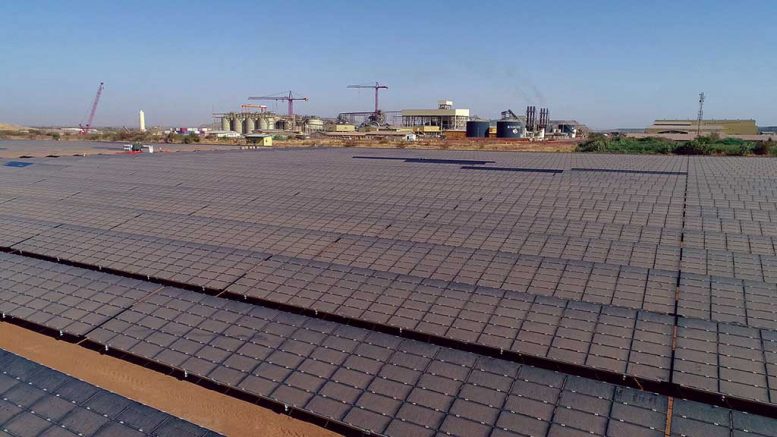
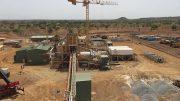
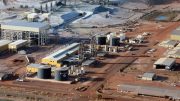
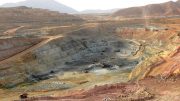
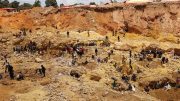
Be the first to comment on "B2Gold inaugurates solar plant at Otjikoto in Namibia"